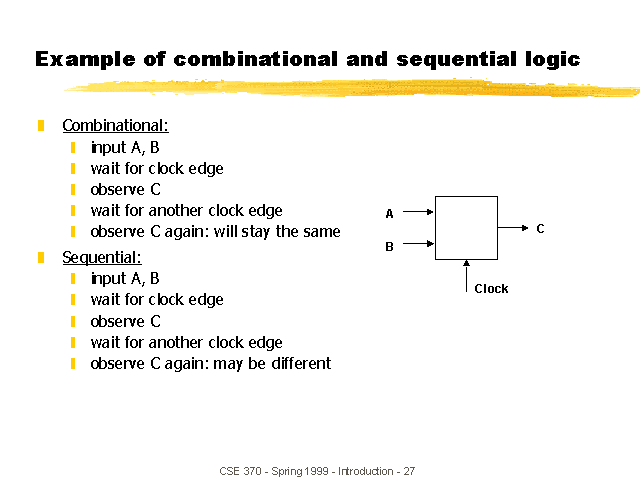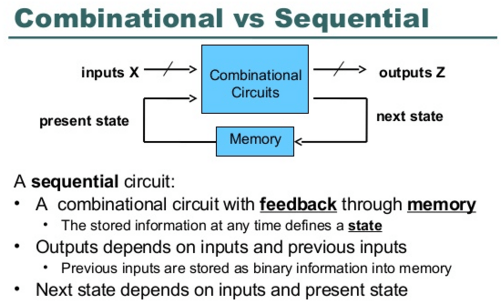
If a sequential circuit is not having any clock signal as input, the output of the circuit will change randomly.

That is it determines when and how the memory elements change their outputs.

These are the instants at which the clock changes from 0 to 1 (a positive edge) or from 1 to 0 (a negative edge).Ĭlock signals control the outputs of the sequential circuit. Square wave with constant frequency is the most common form of clock signal. A clock is a signal, which oscillates between logic level 0 and logic level 1, repeatedly. The clock signal plays a crucial role in sequential circuits. Implemented in: RAM, Registers, counters and other state retaining machines.īack to top C lock Signal in Sequential Circuits
COMBINATIONAL VS SEQUENTIAL LOGIC CIRCUITS FULL
Implemented in: Half adder circuit, full adder circuit, multiplexers, demultiplexers, decoders and encoders. In a sequential circuit the outputs are connected to it as a feedback path. Sequential circuits have some sort of memory as their output changes according to the previous and present values. These circuits will not have any memory as their outputs change with the change in the input value. Output depends on both the present and previous state values of the inputs Output depends only on the present value of the inputs. This is analogous to sequential circuits which changes their state according to the previous and present signals.īack to top Combinational Circuits vs Sequential Circuits So Counter retains the present state of the counter to do next operation. Similarly, it decrements its value depending on its previous and present value. For example to count the number of audience entering or leaving an auditorium or to count number of vehicles in parking.In this when any person enters in to auditorium the counter increments its value depending on its present value. Generally, we come across many counters in our daily life to count the number of objects. Basically, all circuits in practical digital devices are a mixture of combinational and sequential logic circuits. Sequential logic circuits are used to construct finite state machines, which are basic building block in all digital circuitry, and also in memory circuits. The block diagram of a sequential logic is shown below. Sequential circuit uses a memory element like flip – flops as feedback circuit in order to store past values. Sequential circuit can be considered as combinational circuit with feedback circuit. Sequential logic circuits are those, whose output depends not only on the present value of the input but also on previous values of the input signal (history of values) which is in contrast to combinational circuits where output depends only on the present values of the input, at any instant of time. Limitations of Asynchronous Sequential Circuits.Where we use Asynchronous Sequential Circuits?.Limitations of Synchronous Sequential Circuits.



 0 kommentar(er)
0 kommentar(er)
